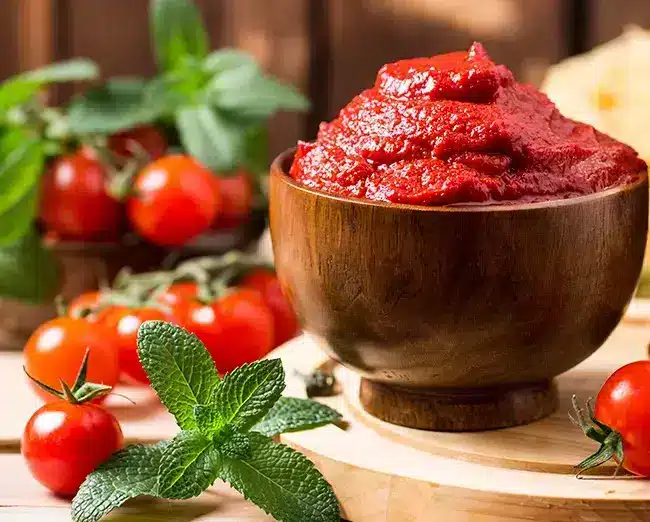What Is Tomato Paste?
Aseptic Tomato Paste is a thick and concentrated mixture prepared from fresh tomatoes. To make tomato paste simply, smashed tomatoes are cooked for hours, then their seeds and skin are filtered, then the remaining liquid is cooked for a longer time to make a thick paste. Tomato paste has many fans all over the world who add it as a seasoning and sauce to their various dishes. If in the processing line, all procedures are done according to the standards, the paste will be sufficiently thick, with its natural taste and color. It will also retain the properties of tomatoes, such as minerals and vitamin C.

Tomato Paste Production Line
The method of producing tomato paste in most factories is almost the same. The steps of tomato paste production include:
- Selection and sorting: The first step for the production of tomato paste is the selection of tomatoes. Ripe and healthy tomatoes are selected and sorted from other tomatoes.
- Washing and drying: Chosen tomatoes are washed carefully by cleaning machines. Then they are air-dried.
- Crushing: After washing and drying, the tomatoes are transferred to a tomato crusher to be crushed into 3-5 mm particles. After that, the crushed tomatoes are transferred to a mixer to be crushed and chopped more until smooth.
- Cool or Hot Break: Tomato paste is preheated to 65-75°C for Cool break (CH) processing or to 85-95°C for Hot break (HB) processing both for 10-15 minutes. HB paste is commonly used for ketchup and ketchup varieties including 28-30° aseptic tomato paste, while CH paste is used for concentrate paste at aseptic tomato paste brix 36-38° Brix.
- Removing water: In this stage, the tomato pulp, which includes the fiber of tomato, juice, and seeds, is sieved through a purifier. Consequently, tomato paste becomes smoother and softer. Normally, 95% of the tomato paste passes through two sieves. And the remaining five percent, which consists of seed fiber and tomato skin, is considered waste.
- Evaporation: The evaporation stage is the most important stage of the tomato paste production process. The tomato paste juice evaporates until the paste reaches the desired concentration and density that increases continuously. The complete process of concentration and evaporation is in vacuum conditions at a temperature of less than 100°C.
- Aseptic filling: Tomato paste is transported directly to the aseptic container, then transferred through the sterilizer cooler in pre-sterilized packages. After packaging, the concentrate can be stored for up to two years.
In some factories, tomato paste is packed in non-aseptic conditions. In this case, after packaging, the tomato paste must go through another step for pasteurization. The tomato paste is heated for pasteurization, then before delivery to the customer, it will be controlled for two weeks under certain conditions.

How to Use Tomato Paste
Tomato paste is one of the main flavorings for preparing food. You can add tomato paste to soup, stew, and any kind of food while cooking to enjoy the aroma, taste, and reddish color of tomatoes. Tomato paste is offered in small packages along with fast foods such as sandwiches, pizzas, and slices of toasted chicken in different flavors. It also can work well in curries and tomato-based dishes.
Since tomato paste is produced and prepared in a very thick form, only one or two tablespoons are enough to cook each meal, so it is better to keep the remaining tomato paste in the refrigerator or freezer for a longer period. Click for More information about Dried fruit bulk wholesale.

| Tomato paste is produced during a special process in factories under completely sterile conditions for uses such as food seasoning or using as sauce and ketchup. |
Nutritional facts
If the tomato paste production line includes modern equipment and the process is done under special conditions, the vitamins and minerals of the tomato will be preserved in it. Tomato paste contains:
- Good content of vitamins C, E, B6, A, and K
- An important source of lycopene
- Calories, Carbohydrates, and Fiber
- Minerals such as copper, potassium, Iron, and Manganese
Price
To determine the final price of tomato paste, the quality and price of fresh tomatoes and the type of packaging are influential factors. In Kourosh Foods Company, canned tomato paste is offered at a reasonable price for consumers all around the world.
Last Note
Kourosh Foods Company produces large batches of aseptic tomato paste Brix 36/38 inside new steel drums. It also provides easy-open canned tomato paste in Iran using a high-quality, state-of-the-art tomato processing line. Mass production of tomato paste by the technological processing equipment (cleaning, picking, crushing, pulping, concentrating, and filling) in a sterile environment fills the aseptic drum with tomato paste. The strength of tomato paste is brix 36-38 and brix 28-30, without any additives, 100% authentic, which can be stored for 1-2 years at room temperature. To order the natural tomato paste call us today.







